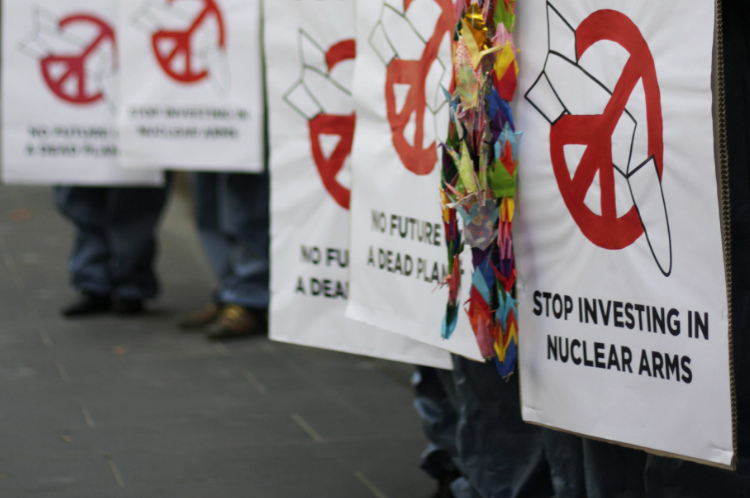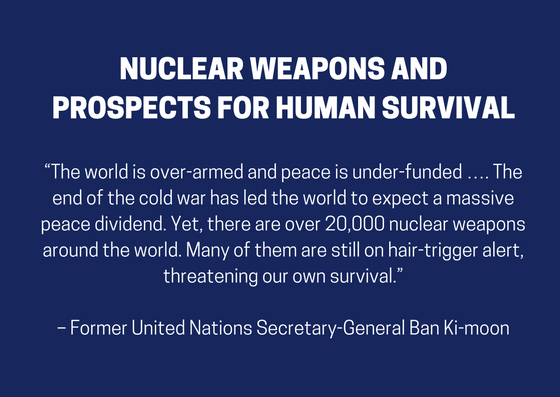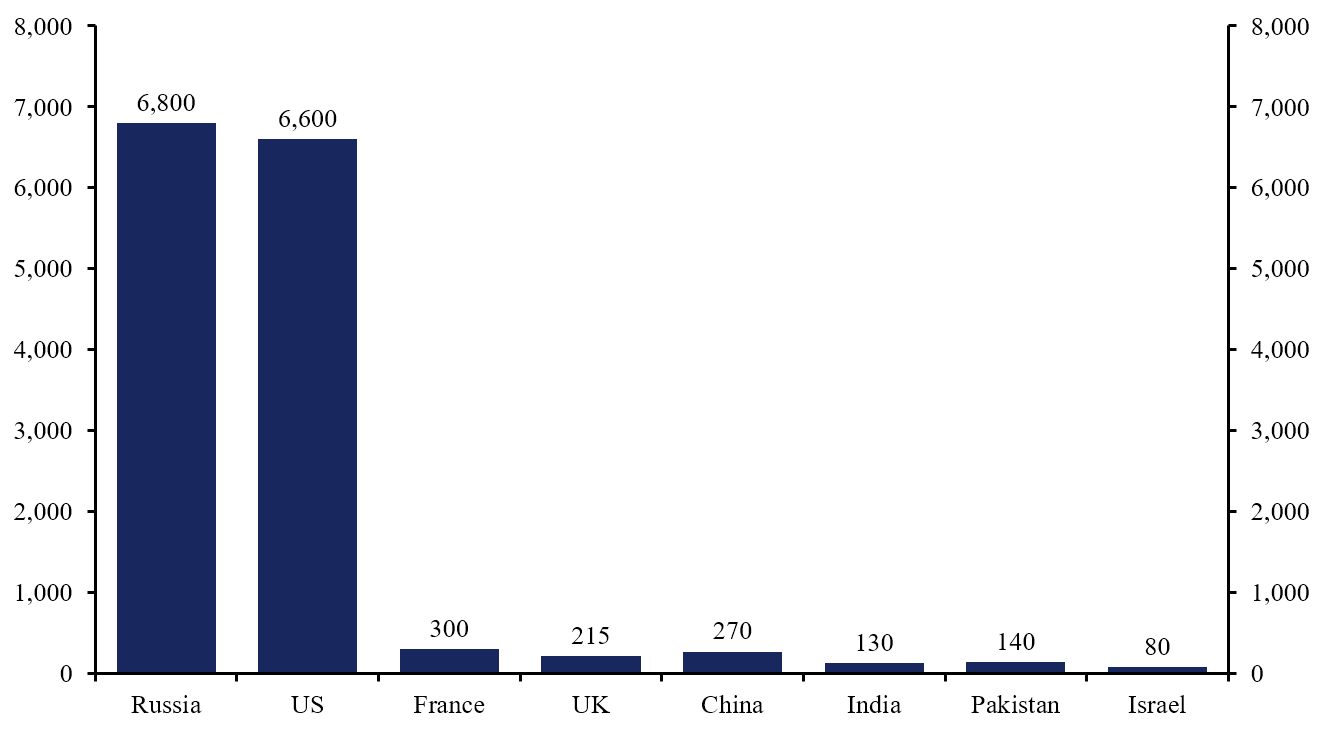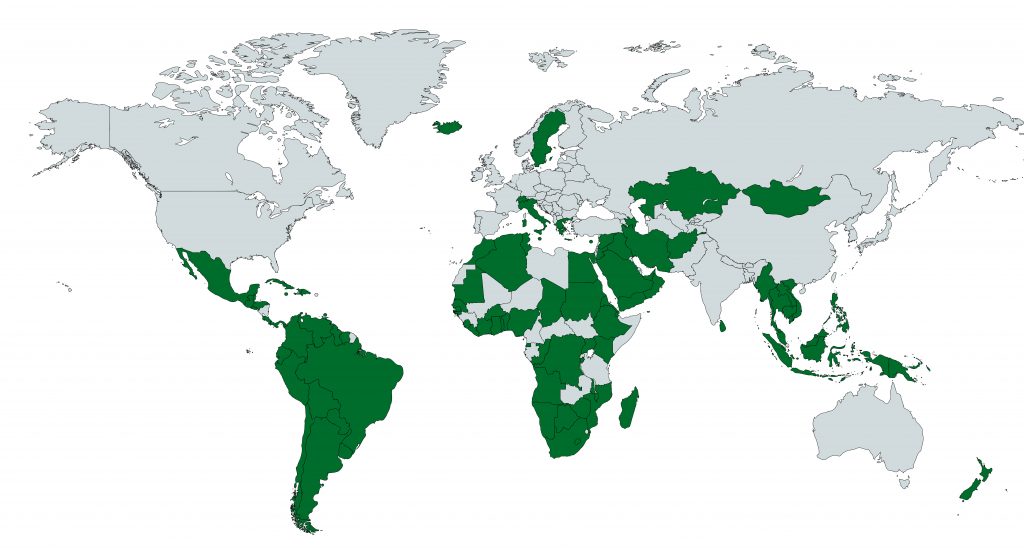The Treaty on the Prohibition of Nuclear Weapons
February 15, 2018 Reading Time: 11 minutes

Reading Time: 11 min read
Image Credit – Tim Wright / International Campaign to Abolish Nuclear Weapons
Malinda Meegoda*
This LKI Explainer analyses key aspects of the ‘Treaty on the Prohibition of Nuclear Weapons’ (the “Nuclear Ban Treaty”), which was adopted on 7 July 2017.
Contents
- Structure of the Nuclear Ban Treaty
- Adoption, Signature, Ratification, and Entry into Force
- State Obligations under the Treaty
- Unique Features of the Treaty
- Critiques of the Treaty
- Withdrawing from the Treaty, and Relationship with Other Instruments
- Enforcement and Future Prospects for the Treaty
- Stance of Nuclear Weapons States and their Allies
- Sri Lanka’s Foreign Policy and Nuclear Weapons
- Implications for Sri Lanka
- Policy Recommendations for Sri Lanka
- Key Readings
Background
On 7 July 2017, 122 states adopted the Treaty on the Prohibition of Nuclear Weapons, also known as The Nuclear Ban Treaty, at a United Nations (UN) conference in New York. The Treaty is the first multilateral treaty adopted at the UN that aims to prohibit the use and maintenance of nuclear weapons.
The UN has long held the objectives of nuclear disarmament, dating back to the very first resolution (on the Establishment of a Commission to Deal with the Problems Raised by the Discovery of Atomic Energy) adopted by the General Assembly in 1946. 1 The most prominent treaty governing non-proliferation and disarmament of WMDs (Weapons of Mass Destruction) has been the Treaty on the Non-Proliferation of Nuclear Weapons (NPT) of 1970.
The Nuclear Ban Treaty was adopted for several reasons, including the following:
- There is a renewed recognition that nuclear weapons pose a grave threat to human civilisation. Despite the decline in nuclear warhead inventories around the world since 1986, the threat of destruction from nuclear weapons has increased, and sometimes to critical levels.2 In addition, the rate of disarmament of nuclear weapons is at its lowest point since the end of the Cold War.
- The international community has already placed bans on other types of WMDs, via the Biological Weapons Convention (BWC) of 1975 and the Chemical Weapons Convention (CWC) of 1997. The BWC and CWC were considered precedents for a treaty to ban the most harmful of WMDs, i.e. nuclear weapons.3
- The Nuclear Weapons States (NWS) failed to adequately address the humanitarian impact of nuclear weapons at previous disarmament fora, especially at the NPT Review Conferences, which take place every five years.4

Figure 1: Estimated Nuclear Warhead Inventories 2017*
Source: Federation of American Scientists, 2017
*Public information on North Korea’s nuclear weapon arsenal is not available. North Korea has reportedly produced fissile material for 10-20 nuclear warheads and detonated four nuclear devices.5
1. Structure of the Nuclear Ban Treaty
- The Preamble to the Treaty states its main objectives and purpose.6 The Preamble recognises:
- The suffering of victims of nuclear weapons, and the existential threat posed by nuclear weapons;
- The importance of existing regimes to control nuclear weapons, such as the NPT, and agreements to establish zones free of nuclear weapons; and
- The right of states to pursue nuclear technology for civilian use.
- The Treaty contains 20 articles, which describe:
- Existing prohibitions of nuclear weapons and state obligations to ensure nuclear safeguards (including measures to verify meeting international commitments under nuclear non-proliferation regimes);
- The obligations of ratifying States Parties to the Treaty (a ‘State Party’ is a country that has ratified a particular treaty);
- The ratification process; and
- Procedures for enforcement and withdrawal from the Treaty.
2. Adoption, Signature, Ratification, and Entry into Force
- Sri Lanka was one of 122 states that voted to adopt the Nuclear Ban Treaty on 7 July 2017 at the UN conference to negotiate a legally-binding instrument to prohibit nuclear weapons.7
- The Treaty was opened for signature on 20 September 2017, at the UN headquarters in New York.8
- The Treaty will enter into force 90 days after the 50th instrument of ratification is deposited.9
- As of 1 February 2018, 56 states have signed the treaty, while only five states (Cuba, Mexico, Guyana, the Holy See, and Thailand) have ratified the treaty.10
- Sri Lanka has neither signed nor ratified the Treaty.
Figure 2: Countries that voted to adopt the Nuclear Ban Treaty
Source: United Nations, 2017 11
*All the NWS and a majority of their allies boycotted the negotiations.
3. State Obligations Under the Treaty
Prohibitions
Article 1 of the Treaty prohibits States Parties from developing, stockpiling, using, threatening to use, acquiring, transferring, and stationing nuclear weapons.12 The prohibitions also extend to any form of assistance for these prohibited acts.
Declarations
Under Article 2, States Parties must submit a declaration to the UN Secretary-General no later than 30 days after the Treaty enters into force, documenting:
- Their history of ownership, possession, and control of nuclear weapons or nuclear explosive devices, and verifications of the elimination of any nuclear programmes; and
- Whether they possess another country’s nuclear weapons on their territory.13
Safeguards
- State Parties that have not possessed or controlled nuclear weapons or other nuclear explosive devices are, after 7 July 2017, obligated to maintain their International Atomic Energy Agency (IAEA) safeguards obligations, “without prejudice” to any future additional agreements.14
- All other State Parties must form a comprehensive safeguards agreement with the IAEA to verify that fissionable material is not diverted towards the production of nuclear weapons. This agreement is known as the INFCIRC/153 – The Structure and Content of Agreements Between the Agency and States Required in Connection with the Treaty on the Non-Proliferation of Nuclear Weapons.15
Victim and Environmental Assistance
- Each State Party is obligated to provide assistance to individuals affected by the use or testing of nuclear weapons in its jurisdiction.
- They must also conduct activities to remedy environmental contamination caused by the testing or use of nuclear weapons.16
4. Unique Features of the Treaty
- Civil society organisations contributed significantly to the negotiation and advocacy of the Treaty.17
- The Treaty the disproportionate impact of nuclear testing on women and girls. This reflects studies that have, for example, demonstrated that the risk of developing cancer from the use of nuclear weapons is higher among women; women were almost twice as likely than men to develop cancer, among the victims of Hiroshima and Nagasaki.18
- The Treaty also notes the disproportionate impact that nuclear weapons testing has had on indigenous peoples around the world.19
- The Treaty encourages current NWS to join the Treaty.20 The disarmament process for NWS is modelled on the CWC and would subject such states to a legally binding and time-bound plan for disarmament, subject to third-party verification systems under the IAEA.
5. Critiques of the Treaty
- The NWS were absent from negotiations leading to the Treaty, which may undermine its efficacy.21
- The Treaty does not have a detailed framework on how to deal with the question of verification with respect to (i) established non-nuclear weapon states (verified states with no prior or existing nuclear weapons program), (ii) transitional nuclear-weapon states (states that commit to eliminating their nuclear weapons programmes when joining the treaty), and (iii) legacy nuclear weapon states (nuclear weapons states with latent capabilities after joining the treaty).22
- The absence of certain definitions in the Treaty has also been criticised.
- Previous nuclear arms reduction treaties such as the Strategic Arms Reduction Treaty (START) and the New Strategic Arms Reduction Treaty (New START), included clear definitions of terms.23 The New START Treaty contains over 90 definitions.
- By comparison, the Nuclear Ban Treaty does not include definitions of key terms such as ‘nuclear weapon,’ ‘nuclear test’ or ‘nuclear programme.’24
- The Treaty has been criticised for diverting attention from existing institutional arrangements that focus on nuclear disarmament and nuclear risk reduction measures.
- Some negotiating parties shared concerns that the Treaty could create a space for ‘forum shopping,’ where, states may attempt to sign on to the Treaty in the hope of circumventing criticism of noncompliance with the strict verification standards in the NPT.25
- Concerns also exist that could divert attention from ongoing negotiations on nuclear risk reduction, resulting in further delays in discussions to implement the Comprehensive Nuclear-Test-Ban Treaty, the Fissile Material Cut-off Treaty (FMCT), and bilateral arms reduction agreements between Moscow and Washington.26
6. Withdrawing from the Treaty, and Relationship with Other Instruments
- The withdrawal period, which is how long each State Party is bound by the Treaty obligations after a notice of withdrawal is officially recognised, is substantially longer (12 months) than that for the NPT (three months).27
- In addition, Article 17 specifies that any party engaged in an armed conflict at the end of the 12-month withdrawal period, would remain bound by the terms of the Treaty until the end of the armed conflict. This provision was added to discourage states from withdrawing from the Treaty to pursue nuclear weapons development in times of armed conflict.28
- The Treaty’s primary goal of prohibiting nuclear weapons could help support the existing obligations of Article 6 of the NPT.29 Article 6 of the NPT obligates States Parties to pursue negotiations in “good faith” to devise effective measures that would lead to global nuclear disarmament.30
7. Enforcement and Future Prospects for the Treaty
- There is no clear mechanism to enforce state obligations under the Nuclear Ban Treaty.
- As the Treaty would only bind ratifying states, it does not make the possession of nuclear weapons illegal for states that are not a party to the Treaty, including the NWS.31
- The Treaty is not yet in effect. However, if widely ratified, the Treaty could help de-legitimise the NWS and ‘shame’ them into altering their practices on nuclear weapons. Supporters of the Treaty have noted the successes achieved by the Ottawa Treaty (Anti-Personnel Mine Ban Convention) in this regard.32
8. Stance of Nuclear Weapons States and their Allies
- The Treaty was publicly rejected by western NWS, who viewed it as a naïve exercise in light of nuclear issues with North Korea. In a joint statement, the United States, the United Kingdom, and France said,
“This initiative clearly disregards the realities of the international security environment. Accession to the ban treaty is incompatible with the policy of nuclear deterrence, which has been essential to keeping the peace in Europe and North Asia for over 70 years.” 33
- In a statement issued on 20 September 2017, the North Atlantic Treaty Organisation’s (NATO) North Atlantic Council (NAC) dismissed the Treaty as ineffective and divisive, and reiterated that any disarmament treaty “must take into account the prevailing international security environment.”34 Similarly, Pakistan and India rejected the Treaty on the grounds that it does not take all stakeholder interests into account.35
9. Sri Lanka’s Foreign Policy and Nuclear Weapons
- Sri Lanka has been consistent throughout its diplomatic history in opposing the use of nuclear weapons, and robustly supporting nuclear non-proliferation and disarmament.36
- During the first conference on the Treaty, the Sri Lankan delegation’s representative and Minister Counsellor, Mr. Niluka Kadurugamuwa, stated that a legally binding instrument prohibiting nuclear weapons has the “transformative power to codify their illegality [which] would stigmatise the possession of nuclear weapons, and ultimately lead towards their total elimination.”37
- Although Sri Lanka voted in favour of adopting the Treaty, it has not yet signed or ratified the Treaty.38
10. Implications for Sri Lanka
- If Sri Lanka chooses not to sign or ratify the Treaty, it could adversely affect the following:
- Sri Lanka’s diplomatic legacy as a consistent advocate of nuclear disarmament;
- Sri Lanka’s credibility as a reliable partner in multilateral, rules-based orders, especially with other smaller states; and
- Sri Lanka’s long-term ambitions of ensuring a peaceful Indian Ocean.
- On the other hand, if Sri Lanka were to ratify the Treaty, it could be criticised for risking its policy of remaining sensitive to the security needs of its nuclear neighbours.
11. Policy Recommendations for Sri Lanka
- Sri Lanka could forge stronger partnerships within the Non-Aligned Movement (NAM) and create minilateral blocs with states such as Indonesia (current Coordinator of the NAM working group on disarmament), to advocate robust action plans on nuclear non-proliferation and nuclear risk reduction.
- Sri Lanka seeks to realise the potential of the Blue Economy in the Indian Ocean region and aims to become a maritime regional hub. Sri Lanka should therefore frame its policies on nuclear issues to minimise the risk of a nuclear conflict in the region, which would threaten its Blue Economy, and maritime hub objectives.
12. Key Readings
Dhanapala, J. (2017). Finally, Nuclear Weapons are Outlawed. IDN-InDepthNews. https://www.indepthnews.net/index.php/armaments/nuclear-weapons/1245-finally-nuclear-weapons-are-outlawed
Jenkins, B. (2017). How a UN Treaty on Nuclear Weapons Makes International Security Policy More Inclusive. Brookings. https://www.brookings.edu/blog/order-from-chaos/2017/07/12/how-a-u-n-treaty-on-nuclear-weapons-makes-international-security-policy-more-inclusive/
Harries, M. (2017). The Real Problem with a Nuclear Ban Treaty. Carnegie Endowment for International Peace. http://carnegieendowment.org/2017/03/15/real-problem-with-nuclear-ban-treaty-pub-68286
Thakur, R. (2017). Understanding the UN’s New Treaty on the Prohibition of Nuclear Weapons. The Strategist. https://www.aspistrategist.org.au/understanding-uns-new-treaty-prohibition-nuclear-weapons/
Notes
1 Resolutions Adopted on the Reports of the First Committee (1946). United Nations. http://www.un.org/en/ga/search/view_doc.asp?symbol=A/RES/1(I)
2 Norris, R., and Kristensen, H. (2010). Global Nuclear Weapons Inventories,1945-2010.Bulletin of the Atomic Scientists. http://journals.sagepub.com/doi/pdf/10.2968/066004008
3The Nuclear Weapon Ban Treaty. (2017). International Campaign to Abolish Nuclear Weapons. http://www.icanw.org/wp-content/uploads/2017/11/ican-2017-Oslo-final.pdf #page=10
4 How the Ban Treaty Works. (2017). The International Campaign to Abolish Nuclear Weapons. http://www.icanw.org/why-a-ban/the-case-for-a-ban-treaty/
5 Potter, W. (2017). Disarmament Diplomacy and the Nuclear Ban Treaty. Survival
6 Kristensen, H. & Norris, R. Status of World Nuclear Forces (2017). Federation of American Scientists. https://fas.org/issues/nuclear-weapons/status-world-nuclear-forces/
7 List of Countries Which Signed Treaty on the Prohibition of Nuclear Weapons (2017). United Nations Office for Disarmament Affairs. https://www.un.org/disarmament/list-of-countries-which-signed-tpnw-on-opening-day-20-september-2017/
8 Ibid
9 United Nations Treaty on the Prohibition of Nuclear Weapons (2017). https://treaties.un.org/doc/Treaties/2017/07/20170707%2003-42%20PM/Ch_XXVI_9.pdf#page=28
10 Voting Results United Nations Conference to Negotiate a Legally Binding Instrument to Prohibit Nuclear Weapons: Second Session (2017). United Nations. https://s3.amazonaws.com/unoda-web/wp-content/uploads/2017/07/A.Conf_.229.2017.L.3.Rev_.1.pdf
11 Treaty on the Prohibition of Nuclear Weapons. (2017). United Nations Treaty Collection. https://treaties.un.org/Pages/ViewDetails.aspx?src=TREATY&mtdsg_no=XXVI-9&chapter=26&clang=_en
12 Ibid
13 United Nations Treaty on the Prohibition of Nuclear Weapons (2017). https://treaties.un.org/doc/Treaties/2017/07/20170707%2003-42%20PM/Ch_XXVI_9.pdf#page=21
13 Ibid
14 United Nations Treaty on the Prohibition of Nuclear Weapons (2017). https://treaties.un.org/doc/Treaties/2017/07/20170707%2003-42%20PM/Ch_XXVI_9.pdf#page=22
15 Ibid
16 United Nations Treaty on the Prohibition of Nuclear Weapons (2017). https://treaties.un.org/doc/Treaties/2017/07/20170707%2003-42%20PM/Ch_XXVI_9.pdf#page=24
17 Mecklin, J. (2017). ICAN wins Nobel Peace Prize for Work on Nuclear Weapons Ban Treaty. Bulletin of the Atomic Scientists. https://thebulletin.org/ican-wins-nobel-peace-prize-work-nuclear-weapons-ban-treaty11171
18 Dimmen, G. A. (2014). Gendered Impacts: The humanitarian impacts of nuclear weapons from a gendered perspective. International Law and Policy Institute. http://nwp.ilpi.org/wp-content/uploads/2014/12/No-5-Gender-impacts.pdf
19 United Nations Treaty on the Prohibition of Nuclear Weapons (2017). https://treaties.un.org/doc/Treaties/2017/07/20170707%2003-42%20PM/Ch_XXVI_9.pdf#page=19
20 Submissions by NGOs (2017). United Nations Conference to Negotiate a Legally Binding Instrument to Prohibit Nuclear Weapons, Leading Towards their Total Elimination. https://www.un.org/disarmament/ptnw/submissions-ngos.html
21 Ifft, E., and Goldring, N. (2017). “Prohibiting Nuclear Weapons: What Now for the Ban Treaty?” The International Institute for Strategic Studies. https://www.iiss.org/en/events/events/archive/2017-7df9/august-4c2c/nuclear-ban-2b5c
22 Potter, W. (2017). Disarmament Diplomacy and the Nuclear Ban Treaty. Survival
23 Ifft, E., and Goldring, N. (2017). “Prohibiting Nuclear Weapons: What Now for the Ban Treaty?” The International Institute for Strategic Studies. https://www.iiss.org/en/events/events/archive/2017-7df9/august-4c2c/nuclear-ban-2b5c
24 Ibid
25 Potter, W. (2017). Disarmament Diplomacy and the Nuclear Ban Treaty. Survival
26 Ibid
27 United Nations Treaty on the Prohibition of Nuclear Weapons (2017). https://treaties.un.org/doc/Treaties/2017/07/20170707%2003-42%20PM/Ch_XXVI_9.pdf#page=28
28 Ibid
29 Ibid
30 United Nations. The Treaty on the Non-Proliferation of Nuclear Weapons. http://www.un.org/en/conf/npt/2005/npttreaty.html
31 Vienna Convention on the Law of Treaties (1969). https://treaties.un.org/doc/publication/unts/volume%201155/volume-1155-i-18232-english.pdf#page=11
32 Ifft, E., and Goldring, N. (2017). “Prohibiting Nuclear Weapons: What Now for the Ban Treaty?” The International Institute for Strategic Studies. www.iiss.org/en/events/events/archive/2017-7df9/august-4c2c/nuclear-ban-2b5c
33 UN News Center (2017). UN conference adopts treaty banning nuclear weapons. http://www.un.org/apps/news/story.asp?NewsID=57139#.WcyBqmiCxPZ
34 North Atlantic Treaty Organization (2017). North Atlantic Council Statement on the Treaty on the Prohibition of Nuclear Weapons. http://www.nato.int/cps/en/natohq/news_146954.htm
35 Hindustan Times (2017). Committed to nuclear disarmament but can’t be party to UN treaty, says India. http://www.hindustantimes.com/india-news/committed-to-nuclear-disarmament-but-un-prohibition-treaty-does-not-contribute-to-international-law-says-india/story-gD5bfjpBtFfFZoBeRf8qAL.html
36 Ladduwahetty, R. (2017). United Nations Nuclear Prohibition Treaty Sri Lanka among brave, principled non-nuclear countries, to vote – Dr. Jayantha Dhanapala. Ceylon Today. http://www.ceylontoday.lk/print20170401CT20170630.php?id=29955
37 The Delegation of Sri Lanka to the United Nations (2017). Statement at the United Nations conference to negotiate a legally binding instrument to prohibit nuclear weapons leading towards their total elimination. United Nations. https://www.un.int/srilanka/statements_speeches/statement-item-b2-topic-2-un-conference-negotiate-legally-binding-instrument
38 Deen, T. (2017). Sri Lanka not likely to sign nuclear weapons ban treaty at UN. The Sunday Times. http://www.sundaytimes.lk/170917/news/sri-lanka-not-likely-to-sign-nuclear-weapons-ban-treaty-at-un-259980.html
39.Fortune. (2017). How War With North Korea Would Impact the Global Commodity Trade. http://fortune.com/2017/08/11/donald-trump-north-korea-global-commodity-trade/
Abbreviations
WMD Weapons of Mass Destruction
BWC Biological Weapons Convention
CWC Chemical Weapons Convention
FMCT Fissile Material Cut-off Treaty
IAEA International Atomic Energy Agency
NWS Nuclear Weapons States, as recognised by the NPT
NATO North Atlantic Treaty Organisation
NAC North Atlantic Council
NPT Non-Proliferation Treaty
NEW START New Strategic Arms Reduction Treaty
START Strategic Arms Reduction Treaty
UN United Nations
*Malinda Meegoda is a Research Associate at the Lakshman Kadirgamar Institute of International Relations and Strategic Studies (LKI) in Colombo. The opinions expressed in this Explainer, and any errors or omissions, are the author’s own.


